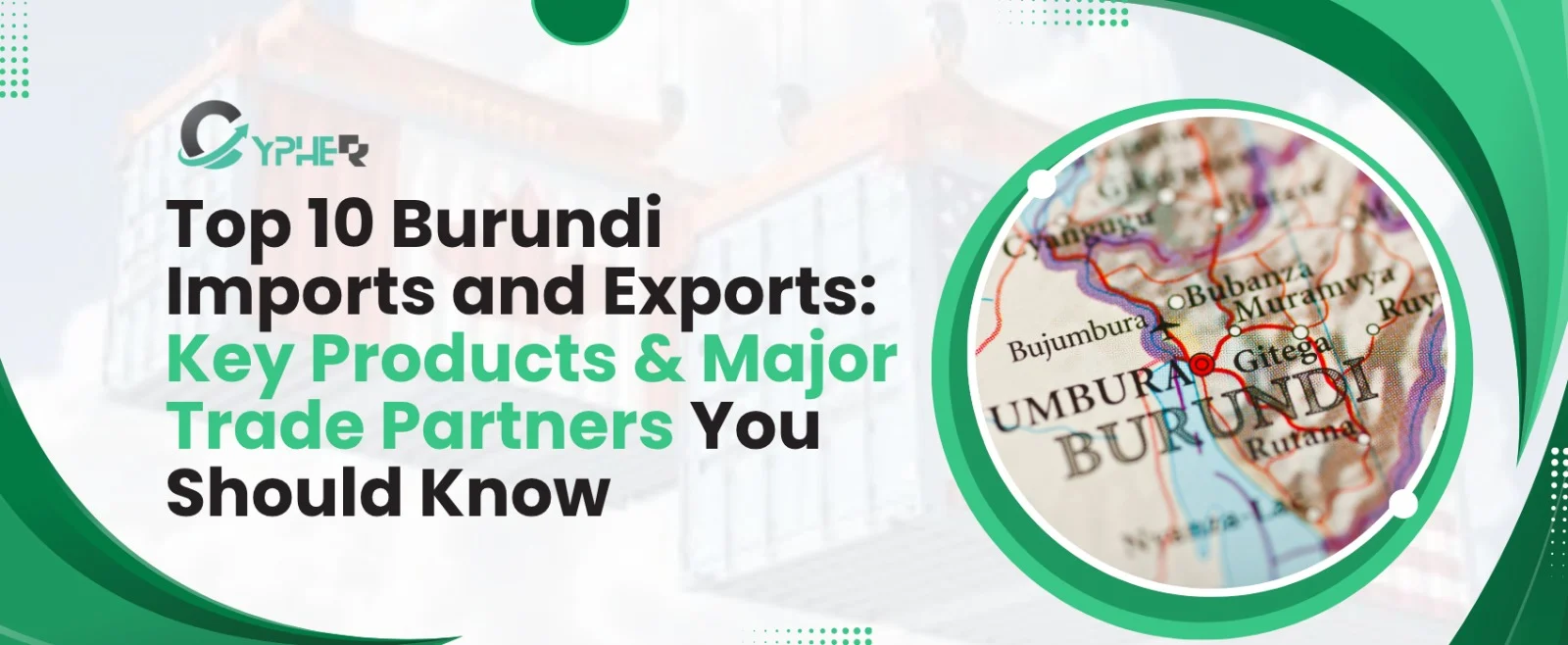Top 10 Burundi Imports and Exports: Key Products & Major Trade Partners You Should Know

06 Aug 2025
In 2023, Burundi’s total trade volume reached 1.4 billion USD, with imports accounting for 1.18 billion USD and exports contributing 217.47 million USD, resulting in a significant trade deficit. This small, landlocked East African nation, nestled between Rwanda, Tanzania, and the Democratic Republic of Congo (DRC), plays a modest yet vital role in global trade. Its economy, heavily reliant on agriculture and emerging mineral exports, is shaped by both regional and international partnerships. For businesses and investors eyeing opportunities in Burundi, understanding its top imports and exports, along with its major trade partners, is essential. By leveraging insights from an exim database or a global import export data provider like Cypher Exim, this blog explores Burundi’s top 10 imports and exports, highlighting key products and trade partners to provide a roadmap for navigating this unique market.
Burundi’s trade dynamics are influenced by its geographic constraints and economic structure. As a landlocked country with a population of approximately 14 million and a GDP of USD2.64 billion, Burundi depends heavily on imports to meet its needs for fuel, machinery, and consumer goods. Its exports, dominated by agricultural products like coffee and tea, reflect the country’s fertile landscapes and historical focus on farming. According to world import export data providers, Burundi ranks as the 178th largest importer and 180th largest exporter globally, underscoring its niche position in international trade. Membership in regional trade blocs, such as the East African Community (EAC) and the Common Market for Eastern and Southern Africa (COMESA), facilitates access to markets in neighboring countries, while global partners like the UAE and China play significant roles in its trade ecosystem.
The importance of reliable trade data cannot be overstated for businesses looking to engage with Burundi. Platforms like Cypher Exim, which are reputed global import export records online providers, offer detailed shipment records, HS codes, and market trends. These tools help traders identify highdemand products, connect with buyers and suppliers, and optimize supply chains. For example, a port data supplier can provide insights into shipment volumes and logistics, enabling businesses to streamline operations in Burundi’s import heavy market.
With this context, let’s dive into the top 10 imports that fuel Burundi’s economy:
Burundi’s imports are driven by the need to support its population and infrastructure development. The country’s top import, mineral fuels and oils (Hsn code 27), accounted for USD263.58 million in 2023, representing 22.29% of total imports. As Burundi lacks domestic oil production, it relies heavily on petroleum products for transportation, electricity, and industry. The United Arab Emirates, supplying USD198.57 million worth of fuels, is the largest import partner for this category, according to Burundi customs data. This dependency underscores the critical role of energy imports in sustaining Burundi’s economy, making it a key focus for suppliers in the global market.
Vehicles (Hsn code 87), valued at 82 million USD, are the second-largest import, comprising 6.56% of the total. Burundi’s landlocked status and growing logistics sector drive demand for cars, trucks, and automotive parts. China and India are primary suppliers, offering cost-effective vehicles that cater to both commercial and personal use. The reliance on imported vehicles highlights opportunities for automotive exporters to tap into Burundi’s transportation needs, particularly as infrastructure projects expand.
Machinery and mechanical appliances (HS Code 84), worth USD70 million, rank third, accounting for 5.56% of imports. These include agricultural equipment and industrial machinery essential for modernizing Burundi’s farming and manufacturing sectors. China, with its competitive pricing, dominates this category, followed by India. Businesses accessing global import export data providers can identify specific machinery in demand, such as tractors or processing equipment, to target Burundi’s growing agricultural sector.
Pharmaceutical products (HS Code 30), valued at USD60 million, make up 4.76% of imports. Burundi’s healthcare system, serving a dense population, relies on imported medicines to address public health challenges. India, known for its generic drug industry, is a major supplier, alongside Belgium, which provides specialized pharmaceuticals. This category presents opportunities for pharmaceutical companies to partner with Burundi’s healthcare providers, supported by data from an Exim Data Provider.
Electrical machinery and equipment (HS Code 85), worth USD47 million, account for 3.75% of imports. Generators, communication devices, and electrical components are critical for Burundi’s infrastructure and connectivity. China leads as the primary supplier, offering affordable solutions for a country working to improve its energy and telecommunications networks. Importers can use global import export data online to track demand trends for specific electrical products in Burundi.
Textiles and textile articles (HS Code 63), valued at USD46 million, represent 3.72% of imports. Clothing, fabrics, and other textile products cater to both consumer and industrial needs. China and Tanzania supply the bulk of these goods, benefiting from regional trade agreements and proximity. The steady demand for textiles makes this a stable import category for businesses looking to enter Burundi’s market.
Cement and related products (HS Code 25), worth USD34 million, account for 2.73% of imports. Burundi’s ongoing infrastructure development, including roads and buildings, drives demand for construction materials. Tanzania and Kenya, leveraging their proximity and EAC membership, are key suppliers. Importers can use port data suppliers to monitor shipment volumes and optimize logistics for cement deliveries to Burundi.
Iron and steel products (HS Code 72), valued at USD28 million, make up 2.22% of imports. These materials, including bars and rods, are essential for construction and manufacturing. India and China dominate this category, offering competitive pricing for high-quality steel. Businesses can leverage exim database insights to identify specific steel products in demand, such as those used in Burundi’s urban development projects.
Sugar and confectionery (HS Code 17), worth USD25 million, represent 2.04% of imports. As a staple in Burundi’s food consumption, sugar is sourced from regional partners like Tanzania and global suppliers like India. This category reflects the country’s need for affordable food imports to support its population, offering opportunities for food exporters to meet this demand.
Plastics and plastic articles (HS Code 39), valued at USD20 million, round out the top 10 imports at 1.69%. Used in packaging, construction, and consumer goods, plastics are primarily supplied by China and the UAE. The versatility of plastics makes this a growing import category, with global import export data providers offering insights into specific products like packaging materials that are in high demand.
Shifting focus to exports, Burundi’s USD217.47 million in export revenue is heavily concentrated in agricultural and mineral products. Coffee (HS Code 09), valued at USD62.1 million, is the cornerstone of Burundi’s exports, accounting for 57.1% of the total. Renowned for its high-quality Arabica beans, Burundi exports coffee primarily to Switzerland and the DRC, where it commands premium prices in specialty markets. Exporters can use world import export data providers to identify buyers seeking Burundi’s premium coffee.
Gold (HS Code 71), worth USD34.1 million, is the second-largest export, contributing 15.7% to the total. Unwrought gold, sourced from Burundi’s growing mining sector, is primarily exported to the UAE and Switzerland. The rising global demand for gold presents opportunities for investors to support Burundi’s mining industry, with trade data helping to pinpoint profitable markets.
Tea (HS Code 09), valued at USD26.9 million, accounts for 12.4% of exports. Burundi’s tea, known for its robust flavor, is exported to the DRC and Belgium, among others. The country’s tea industry benefits from government support, making it a reliable export for businesses looking to enter global beverage markets.
Tin ores and concentrates (HS Code 26), worth USD6.1 million, represent 2.8% of exports. Exported to industrial markets in China and Belgium, tin is a growing contributor to Burundi’s economy. The mining sector’s expansion offers opportunities for exporters to leverage global import export data online to connect with buyers in need of raw materials.
Iron and steel bars (HS Code 72), valued at USD5.2 million, account for 2.4% of exports. These products are shipped to regional markets like the DRC and Tanzania, supporting construction and manufacturing. Burundi’s ability to export steel highlights its emerging industrial capacity, with trade data helping exporters identify regional demand.
Processed petroleum oils (HS Code 27), worth USD2.4 million, contribute 1.1% to exports. Despite limited oil production, Burundi exports processed oils to neighboring countries, leveraging regional trade networks. This niche export category shows the potential for growth in Burundi’s energy sector.
Copper waste and scrap (HS Code 74), also valued at USD2.4 million, represent 1.1% of exports. Exported to Belgium, this category reflects Burundi’s role in global recycling and raw material supply chains. Businesses can use exim database insights to target markets seeking copper scrap.
Hydraulic cements (HS Code 25), worth USD1.7 million, account for 0.8% of exports. Exported to the DRC and Tanzania, cement supports regional construction needs, showcasing Burundi’s growing industrial output. Regional trade agreements enhance the competitiveness of this export.
Raw hides and skins (HS Code 41), valued at USD1.7 million, also contribute 0.8% to exports. Exported to China, these materials support the global leather industry, offering opportunities for exporters to tap into this niche market.
Soap and organic surface-active products (HS Code 34), worth USD1.1 million, round out the top exports at 0.5%. Exported to the DRC, these consumer goods reflect Burundi’s small but growing manufacturing sector. Trade data can help exporters identify regional buyers for similar products.
Burundi’s major trade partners shape its import and export landscape. For imports, the UAE leads with USD198.57 million, primarily supplying mineral fuels. China and India follow, providing machinery, vehicles, and pharmaceuticals. Tanzania and Kenya, as regional partners, supply cement and sugar, benefiting from EAC trade agreements. For exports, the DRC is the largest market, particularly for coffee and tea, followed by Switzerland and the UAE for coffee and gold. Belgium and China also play significant roles, importing tea, tin, and copper scrap. These partnerships, detailed by port data suppliers, highlight Burundi’s reliance on both regional and global markets.
Burundi’s trade profile presents both challenges and opportunities. The country’s trade deficit, driven by high import dependence, is exacerbated by its landlocked status, which increases logistics costs. However, its agricultural strengths in coffee and tea, combined with a growing mining sector, offer avenues for growth. Businesses can use global import export data providers to identify high-value markets, such as specialty coffee buyers in Europe or mineral importers in Asia. Additionally, investments in agricultural processing and mining infrastructure could enhance export value, while regional trade agreements reduce barriers for exporters.
For businesses, leveraging trade data is key to success in Burundi. Platforms like Eximpedia or Cypher Exim provide shipment records, buyer-supplier connections, and market trends, enabling informed decision-making. For example, a world import export data provider can help exporters target coffee buyers in Switzerland or importers source affordable machinery from China. By understanding Burundi’s top products and trade partners, businesses can navigate its market with confidence, capitalizing on its unique position in East African trade.
In conclusion, Burundi’s trade landscape, though modest in scale, is vibrant and full of untapped potential. Its top imports, ranging from fuels to pharmaceuticals, highlight the needs of a developing economy, while its exports, led by coffee and gold, reflect the nation’s rich agricultural and mineral resources. Key trade partners such as the UAE, DRC, and China play a pivotal role in driving Burundi’s trade activities, opening doors for global businesses to explore new opportunities. By leveraging global import export data online, traders and investors can gain deeper insights into Burundi’s trade performance and emerging sectors. Accessing reliable data sources like the Import and Export Data of India, comprehensive Import Export Databases, and detailed Export Data enables businesses to analyze market trends, discover high-demand products, and identify potential trade partners with precision. With the right trade intelligence tools, such as those offered by Cypher Exim, companies can make informed, data-driven decisions — unlocking Burundi’s growing market and positioning themselves for success in the global trade ecosystem.







